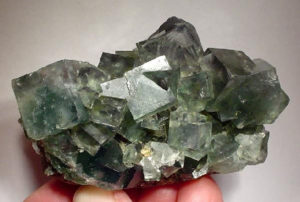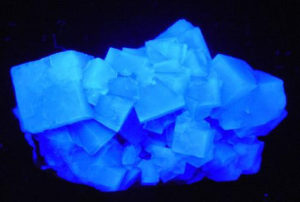Origin of the Word Fluorescence
The term fluorescence is derived from the name of a rock.
It is often the case that a physical phenomenon is observed well before it is named. For fluorescence this gap was almost 300 years. Anomalous colors of natural substances under different illuminations were noted as early as 1565. The red emission of chlorophyll extracts upon illumination by shorter wavelengths was noted by Sir David Brewster in 1833. It was left to Sir George Stokes (1819 – 1903), a mathematics professor at the University of Cambridge, to give the effect its name. In the early 1850’s Stokes noted the color shifting effects in the mineral fluorspar and investigated in greater detail. A key experiment was using a prism to isolate ultraviolet light and observe blue emission. He was first inclined to call this ‘dispersive reflection’, implying a reflection to a different wavelength. He wrote:
“I confess that I do not like this term. I am almost inclined to coin a word, and call the appearance fluorescence, from fluor-spar, as the analogous term opalescence is derived from the name of a mineral.”
The name ‘fluorspar’ is itself derived from the Latin ‘fluo’, for flow, and ‘spar’, a term referring to non-metallic minerals. Fluorspar was given this name because it melts easily.
The offset between the peak excitation wavelength and the peak emission wavelength is called the ‘Stokes shift’ in honor of its discoverer, George G. Stokes.
(Click image for larger view)
- Fluorite, white light
- Fluorite, fluorescence
Images of fluorite under white light (left) and fluorescing. Used under Creative Commons License.
Attribution: Rob Lavinsky, iRocks.com – CC-BY-SA-3.0


